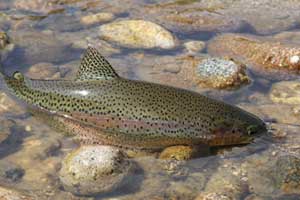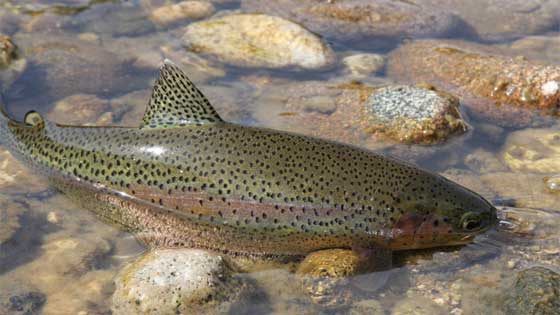Rainbow Trout Summer Fishing

Rainbow Trout are more active in the evening and into the night in early summer. Their food preferences include insects, both aquatic and terrestrial, as well as common baitfish for the watershed that they’re in.
- When fishing into the evening pay careful attention to your shadow and position to avoid scaring them off.
Tip: A good practice before handling bait and lures is to pick up some dirt. Rub it all over your hands and then wipe the dirt off using grass. Then dip your hands in water and wash off the remaining dirt.
Best bait
We like using both live baits and lures. When the water’s clear, as it is most of the time, we prefer using live bait. Nothing imitates the life-like movement of wounded baitfish like real bait.
Successful live baits include earthworms, leeches, alewife, smelt and fathead minnows to name a few.
- When fishing at night, lures work best that use spinners and spoons because of the light amplification created by the spoons and spinners.
Rainbow Trout fishing rigs
Bait and lure presentations should be kept simple.
Baitcasting from the shore of a lake is just as effective as trolling or fly fishing.
Fly fishing is much better when fishing in rivers and streams. The use of dry flies will prevent getting your fly caught on some underwater obstruction. (Though this shouldn’t be as much of a concern for experienced anglers.)
Dry flies will make the learning experience much more enjoyable for novice anglers.
- An ultralight spinning rod with a small reel is sufficient.
- Use a monofilament line of 4 to 6 lbs
- For steelhead, a medium strength rod and reel are best as these fish are larger and put up a greater fight. Using a light line will exhaust them to where they are unlikely to survive release.
Fly fishing gear and technique
A 9 ft fly rod with a weight-forward sinking line is a good bit of kit for catching either Steelhead or Rainbow Trout.
In summer, both Steelhead and Rainbow Trout are found in deep water.
- Cast upstream into pools and riffles
- Let the fly drift but twitch the line every several seconds
- If you see Rainbow Trout or Steelhead Trout following the fly but not biting, change it up with a different fly.
Excellent flies to be using for Rainbow or Steelhead Trout are
- dragon flies
- deer hair flies
- damsel flies
- mayflies
Scents and Shadows
Rainbow Trout are more sensitive to the shadow cast onto the water as the sun begins to set. Be mindful of what you’re wearing as colors that blend into the background are less noticeable. You still need to be careful of where your shadow is cast and avoid sudden movements.
We’re not big proponents of using scents to attract fish. Natural baits are sufficiently scented enough and spinners and spoons have the reflection, which make up for scent in low light and highly turbid waters.
It’s possible to turn off Rainbow Trout if you’re handling live bait with your hands and have a smell of gas or tobacco on them. These scents will turn away Rainbow trout and make your outing less successful.
Steelhead Trout vs Rainbow Trout
Rainbow Trout and Steelhead Trout are the same species. Steelhead are larger and put up a greater fight than the Rainbows as they are seagoing and spend most of their life in the ocean.
They grow larger due to a more abundant selection of foods. This is a common trait of all sea-going salmonides.
They can be found along the west coast of the United States and Canada and in the coastal rivers and streams that feed into the Pacific Ocean. Along the east coast you’ll find them in the Great Lakes, Lake Simcoe and many other Ontario and Quebec lakes and their rivers and streams including the New England states and mountain states.



